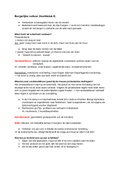Samenvatting
2DBN00 - Summary Linear Algebra
- Instelling
- Technische Universiteit Eindhoven (TUE)
This is a summary of the course 2DBN00 based on handwritten notes that I made when I took and finished the course in 2018/2019. This document contains a summary of the topics treated in the lectures and book of this course. If you want a cheaper price, please message me directly.
[Meer zien]














